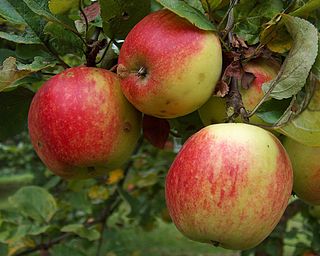
'Pinova' is a German apple cultivar. It was created in 1965 at the Institut für Obstforschung of Dresden–Pillnitz in Saxony which at that time was in the German Democratic Republic. After Germany was re-united in 1990, the rights to the cultivar passed to the Free State of Saxony.

The Braeburn is a cultivar of apple that is firm to the touch with a red/orange vertical streaky appearance on a yellow/green background. Its color intensity varies with different growing conditions.

Russet apples are varieties and cultivars of apples that regularly exhibit russeting, partial or complete coverage with rough patches of greenish-brown to yellowish-brown colour. While russeting is generally an undesirable trait in modern cultivars, russet varieties are often seen as more traditional, and associated with aromatic flavours.

A pearmain, also formerly spelled "permain", is a type of apple. The name may once have been applied to a particular variety of apple that kept well, although in more modern times its inclusion in varietal names was, like the term 'Pippin', "largely decoration" rather than indicating any shared qualities.

Ashmead's Kernel is a triploid cultivar of apple. Traditionally, Ashmead's Kernel was thought to be diploid but a poor pollinator.

'Adams Pearmain', also called 'Adam's Parmane', is a cultivar of apple. It was introduced to the Horticultural Society of London in 1826 by Robert Adams, under the name 'Norfolk Pippin'. The fruit is large, varying from two and a half inches to three inches high, and about the same in breadth at the widest part. It is pearmain-shaped, very even, and regularly formed. The skin is pale yellow tinged with green, and covered with delicate russet on the shaded side; but deep yellow tinged with red, and delicately streaked with livelier red on the side facing the sun. The flesh is reddish, crisp, juicy, rich, and sugary, with an agreeable and pleasantly perfumed flavor. This Cultivar is a sibling of Reinette de Hollande, a hybrid between Reinette Franche’ and ‘Reinette des Carmes. (5)
Table apples are a group of apple cultivars grown for eating raw as opposed to cooking or cidermaking. Table apples are usually sweet and the most prized exhibit particular aroma variations that differentiate them from other apples. D = Dual purpose

The 'Laxton's Superb' is an apple cultivar that was developed in England in 1897. It is a cross breed between Cellini and 'Cox's Orange Pippin' and is not a cross between Wyken Pippin and Cox Orange Pippin. It is a British apple with a green color and a dull red flush. It is a firm-textured dessert apple. The fruit is well known for its sweet and aromatic taste which is likened to the parent species it is derived from, the 'Cox's Orange Pippin'.

Lord Lambourne is an apple cultivar with a sweet sharp flavor. It was raised by Laxtons Brothers Ltd in 1907 in Bedford, England. Received a Royal Horticultural Society Award of Merit in 1923.

'Geheimrat Dr. Oldenburg' is a German apple cultivar. It was created in 1897 at the Höheren Lehranstalt für Obstbau of Geisenheim in the Rheingau, in Hesse in central Germany. It may also be known as 'Geheimrat Doktor Oldenburg', 'Geheimrat Oldenburg', or simply 'Oldenburg'. It is a quite different apple from the older Russian cultivar 'Duchess of Oldenburg', also sometimes known simply as 'Oldenburg'.

'Clivia' is a German apple cultivar. It was created at the Institut für Acker- und Pflanzenbau of Müncheberg, in Märkisch-Oderland in eastern Germany, which at that time was in the German Democratic Republic. It is a hybrid of 'Geheimrat Dr. Oldenburg' and 'Cox's Orange Pippin'. It was reported as a new variety in 1964 and 1965; it was parent of a new cultivar, 'Pinova', in 1965.

'Akane', also known as 'Tokyo Rose', 'Tohoku No.3' and 'Prime Red', is a Japanese cultivar of domesticated apple, that according to Orange Pippin is one of the best early season apples.

'Worcester Pearmain' is an early season English cultivar of domesticated apple, that was developed in Worcester, England, by a Mr. Hale of Swanpool in 1874. It was once the most popular cultivar in England for early autumn harvest and is still popular to keep in the garden. It has been extensively used in apple breeding.

'Allington Pippin' is an English cultivar of domesticated apple, with a strong flavour that includes hints of pineapple.

'Alkmene' is a German cultivar of domesticated apple, also called 'Early Windsor'.

'Duchess of Oldenburg' is an old Russian cultivar of cultivated apple which has attractive streaks of yellow and red. It was commonly but not universally known in America simply as 'Oldenburg' after the American Pomological Society listed that as the official name, a name also used for the 'Geheimrat Dr. Oldenburg' cultivar. The skin of the apple is more prominently striped than that of 'Geheimrat Dr. Oldenburg'.

Ellison's Orange is an English cultivar of domesticated apple, it is a cross between the famous Cox's Orange Pippin and Cellini, which it resembles at most in looks and taste, but can develop a distinct aniseed flavor in storage. The variety is much more disease resistant than Cox's and therefore easier to cultivate.

Winston is an English cultivar of domesticated apple which was first named Winter King because of its availability in the winter, but was renamed as Winston in 1944 or in 1945, after Winston Churchill.

Suntan is an English cultivar of domesticated apple that have earned the Award of Garden Merit by the Royal Horticultural Society in 1999.
10 Howard, N. P., Micheletti, D., Luby, J. J., Durel, C. E., Denancé, C., Muranty, H., … Albach, D. C. (2022). Pedigree reconstruction for triploid apple cultivars using single nucleotide polymorphism array data. Plants People Planet, (March), 1–14. https://doi.org/10.1002/ppp3.10313


























